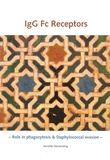IgG Fc Receptors
Role in phagocytosis & Staphylococcal evasion

Stemerding, Annette
- Promoter:
- Prof.dr. J.A.G. (Jos) van Strijp & prof.dr. J.G.J. (Jan) van de Winkel
- Co-promoter:
- Dr. C.P.M. (Kok) van Kessel & dr. G. (Gestur) Vidarsson
- Research group:
- Strijp
- Date:
- September 25, 2014
- Time:
- 10:30 h
Summary
Immunoglobulins protect the host against pathogens. Besides their neutralizing properties, immunoglobulins provide the humoral immune system with target specificity. The most prominent serum immunoglobulin in humans is IgG. After recognizing bacterial surface antigens, for example, IgG activates both humoral and cellular antibacterial immune responses. Through binding of C1q, it activates the ‘classical pathway’ of complement leading to enhancement of opsonization, formation of lethal membrane attack complexes, and chemotaxis of phagocytes. Phagocytes ingest opsonized targets through both complement receptors (CR) and IgG Fc receptors (FcR). The latter family of proteins include the family of leukocyte IgG FcR (FcγR) and the intracellular neonatal Fc receptor (FcRn). In addition, the tripartite motif-containing protein 21 (TRIM21) can sense IgG-opsonized particles in the cytosol, leading to further activation of cells, and proteasomal destruction of targets. The studies presented in the first part of this thesis focus on exploring features of IgG-FcR interactions in phagocytosis. We address the expression and function of a novel phagocyte IgG receptor, the neonatal Fc receptor (FcRn) in phagocytes and investigated the roles of different IgG heavy chain subclasses and light chain isotypes in the light of differential interaction of IgG with its receptors.
Staphylococcus aureus (S. aureus) is a common cause of serious infections and is notorious for the expression of immunomodulatory molecules, that thwart effective host immune responses and mediate immune escape. IgG-mediated opsonophagocytosis by neutrophils is a central line of defense against S. aureus infection. The studies described in the second part of this thesis focus on the bacterial escape of IgG-mediated immune responses. We describe the identification of two potent staphylococcal FcγR antagonists and review the latest knowledge on strategies S. aureus may use to defy IgG-mediated immunity. These include proteins that bind and interfere with IgG-functions, like staphylococcal protein A (SpA), the second binder of Ig (Sbi) and staphylococcal superantigen-like protein 10 (SSL10), staphylokinase (SAK) capable of cleaving IgG, and finally the formyl peptide receptor-like I inhibitor (FLIPR) and FLIPr-like that bind and block leukocyte FcγR. We propose a new model for how these proteins may manipulate IgG-mediated immune responses in order to evade phagocytosis, and contribute to S. aureus survival.
Altogether the studies summarized in this thesis resulted in a better understanding of the biology of IgG Fc receptors during phagocytosis and, furthermore, increased knowledge on host-pathogen interactions central in S. aureus pathogenesis. Collectively, this may facilitate the development of more effective anti-staphylococcal and other therapies to benefit human patients.